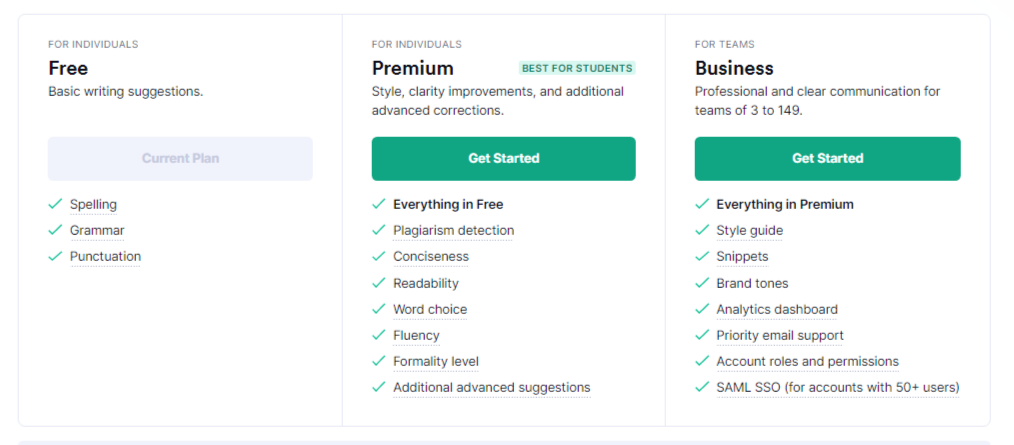The Grammarly pricing section is effective for several reasons:
1. Clear Hierarchy and Visual Appeal:
- Distinct Tiers: The “Free,” “Premium,” and “Business” tiers are clearly labeled and visually separated.
- Target Audience Labels: The “FOR INDIVIDUALS” and “FOR TEAMS” labels clearly define the target audience for each tier.
- “BEST FOR STUDENTS” Highlight: The “Premium” tier is highlighted as “BEST FOR STUDENTS,” guiding user choice.
- Consistent Layout: Each tier follows a consistent layout with descriptions, features, and call-to-action buttons.
- Visual Cues: Checkmarks are used to indicate included features, enhancing readability.
- Clear Headings: The headings clearly indicate the purpose and target audience of each tier.
- Call to Action Buttons: The “Current Plan” and “Get Started” buttons are visually distinct and clearly labeled.
2. Value-Based Differentiation:
- Targeted Descriptions: Each tier has a concise description that clearly identifies the target customer and their needs.
- Feature Progression: The “Everything in [Previous Tier]” structure clearly highlights the added value of higher tiers.
- Specific Feature Differentiation: Features like “Plagiarism detection,” “Style guide,” and “SAML SSO” differentiate the higher tiers.
- Free Option: The “Free” tier offers a starting point for users with basic needs.
3. Transparent Pricing:
- Free Tier Indication: The “Free” tier is clearly labeled and its features are listed.
- Call to Action: The “Get Started” buttons provide clear paths for action.
- “Current Plan” Tag: The “Current Plan” tag lets users know which plan they are currently on.
4. Addressing Different User Needs:
- Basic Needs: The “Free” tier caters to individuals with basic writing needs.
- Advanced Corrections: The “Premium” tier is designed for individuals needing more advanced corrections and features.
- Teams: The “Business” tier caters to teams needing collaboration and advanced features.
5. Strategic Use of Information:
- Benefit-Oriented Features: Features like “Plagiarism detection,” “Style guide,” and “Analytics dashboard” highlight the value of each tier.
- Clear Call to Action: The call-to-action buttons provide clear paths for action.
- Feature Lists: The feature lists clearly show the differences between the tiers.
- Concise Descriptions: The descriptions are brief and to the point, making it easy to understand the purpose of each tier.



